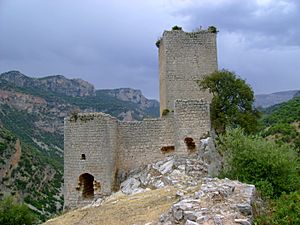Siege of Jaén (1230) facts for kids
Quick facts for kids Siege of Jaén |
|||||||
|---|---|---|---|---|---|---|---|
| Part of the Reconquista | |||||||
 The Castillo de Otíñar which was captured in 1229 by Ferdinand III's forces in preparation for the eventual siege of Jaén. |
|||||||
|
|||||||
| Belligerents | |||||||
Taifa of Baeza |
Taifa of Jayyān (جيان) | ||||||
| Commanders and leaders | |||||||
| Unknown | |||||||
| Strength | |||||||
| Unknown | Unknown | ||||||
| Casualties and losses | |||||||
| Unknown | Unknown | ||||||
The Siege of Jaén in 1230 was a major event during the Reconquista. The Reconquista was a long period when Christian kingdoms in Spain tried to take back control of the Iberian Peninsula from Muslim rulers. This siege happened in the city of Jaén.
The attack on Jaén lasted from June 24 to September 1230. Forces from the Kingdom of Castile, led by King Ferdinand III of Castile, tried to capture the city. Jaén was defended by the Taifa of Jayyān, a Muslim kingdom. The siege ended when the Castilian forces left. This happened because King Alfonso IX of León, Ferdinand III's father, passed away.
Contents
Why the Siege Happened: A Look at the Past
In 1229, King Ferdinand III of Castile started his military campaigns again. He had been fighting against his Muslim neighbors since 1224. In 1225, he had tried to capture Jaén before, but it didn't work. His forces, along with those from the Taifa of Baeza, had to leave. They didn't have enough special equipment to break through the city's strong defenses.
In 1229, Ferdinand III began attacking areas around Jaén. He captured the castle at Otíñar. This castle was very important for controlling the area and preparing for a siege of Jaén. His forces also raided and took goods from the lands around the city. Throughout 1229, Ferdinand III kept preparing for his big attack on Jaén the next year. He captured strong points to get ready for the siege.
The Siege of Jaén: A Tough Battle
On June 24, 1230, King Ferdinand III of Castile officially began the siege of Jaén. He was determined to capture the city this time. Jaén had successfully defended itself against his last attempt five years earlier.
The siege in 1230 was even harder than the one in 1225. The city's defenses had been made much stronger by the ruling Taifa of Jayyān. They expected more attacks from Castile. Because of these stronger defenses, Ferdinand III needed a much larger army to finally take the city.
Knights of Ávila: A Difficult Position
According to an old book called the Chronicle of Ávila, knights from Ávila were part of the Castilian army. They were placed on the Cerro del Neveral (Neveral Hill). This hill was right in front of the castle walls. It seems they were put there as a punishment. They had arrived late to the previous siege five years before. This shows that King Ferdinand III was very strict. From this position, the knights of Ávila were constantly attacked by the city's trebuchets, which were large stone-throwing machines.
mandolos possar el rey en una cabeza que es sobre el alcaçar, e era logar que non se podrien acorrer quando menester les fuesse los de la hueste...
—Crónica de Ávila.
By September, after about four months of fighting, Ferdinand III had to stop the siege early. This was the second time he had to withdraw from Jaén. The reason this time was the death of his father, King Alfonso IX of León. Ferdinand III ordered his army to leave Jaén. He then traveled to Orgaz to meet his mother, Berengaria of Castile. Together, they went to León. There, Ferdinand III, who was already King of Castile, was also crowned King of León and Galacia.
What Happened Next: The Future of Jaén
After the siege, Jaén remained an independent Muslim kingdom for some time. Later, it became part of the Emirate of Granada. Jaén was finally captured by Castilian forces in 1246. King Ferdinand III of Castile returned with his army and members of the Order of Santiago. They were led by Paio Peres Correia, the Grand Master of the Order of Santiago. They defeated a Granadan army led by Muhammad I and finally took the city in the Siege of Jaén (1245-46).
See also
 In Spanish: Asedio de Jaén (1230) para niños
In Spanish: Asedio de Jaén (1230) para niños
- Jaén, Spain
- List of Castilian Battles
- Ferdinand III of Castile

